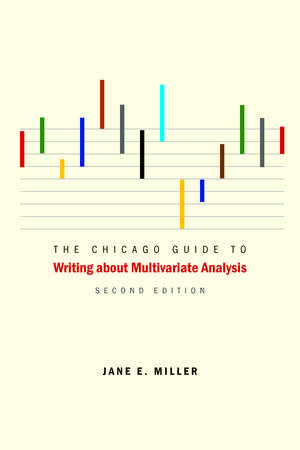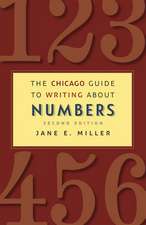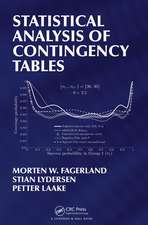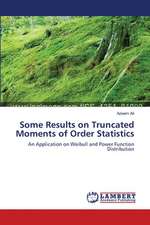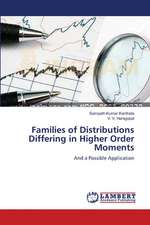The Chicago Guide to Writing about Multivariate Analysis, Second Edition: Chicago Guides to Writing, Editing, and Publishing
Autor Jane E. Milleren Limba Engleză Paperback – 23 iul 2013
Many different people, from social scientists to government agencies to business professionals, depend on the results of multivariate models to inform their decisions. Researchers use these advanced statistical techniques to analyze relationships among multiple variables, such as how exercise and weight relate to the risk of heart disease, or how unemployment and interest rates affect economic growth. Yet, despite the widespread need to plainly and effectively explain the results of multivariate analyses to varied audiences, few are properly taught this critical skill.
The Chicago Guide to Writing about Multivariate Analysis is the book researchers turn to when looking for guidance on how to clearly present statistical results and break through the jargon that often clouds writing about applications of statistical analysis. This new edition features even more topics and real-world examples, making it the must-have resource for anyone who needs to communicate complex research results.
For this second edition, Jane E. Miller includes four new chapters that cover writing about interactions, writing about event history analysis, writing about multilevel models, and the “Goldilocks principle” for choosing the right size contrast for interpreting results for different variables. In addition, she has updated or added numerous examples, while retaining her clear voice and focus on writers thinking critically about their intended audience and objective. Online podcasts, templates, and an updated study guide will help readers apply skills from the book to their own projects and courses.
This continues to be the only book that brings together all of the steps involved in communicating findings based on multivariate analysis—finding data, creating variables, estimating statistical models, calculating overall effects, organizing ideas, designing tables and charts, and writing prose—in a single volume. When aligned with Miller’s twelve fundamental principles for quantitative writing, this approach will empower readers—whether students or experienced researchers—to communicate their findings clearly and effectively.
The Chicago Guide to Writing about Multivariate Analysis is the book researchers turn to when looking for guidance on how to clearly present statistical results and break through the jargon that often clouds writing about applications of statistical analysis. This new edition features even more topics and real-world examples, making it the must-have resource for anyone who needs to communicate complex research results.
For this second edition, Jane E. Miller includes four new chapters that cover writing about interactions, writing about event history analysis, writing about multilevel models, and the “Goldilocks principle” for choosing the right size contrast for interpreting results for different variables. In addition, she has updated or added numerous examples, while retaining her clear voice and focus on writers thinking critically about their intended audience and objective. Online podcasts, templates, and an updated study guide will help readers apply skills from the book to their own projects and courses.
This continues to be the only book that brings together all of the steps involved in communicating findings based on multivariate analysis—finding data, creating variables, estimating statistical models, calculating overall effects, organizing ideas, designing tables and charts, and writing prose—in a single volume. When aligned with Miller’s twelve fundamental principles for quantitative writing, this approach will empower readers—whether students or experienced researchers—to communicate their findings clearly and effectively.
Din seria Chicago Guides to Writing, Editing, and Publishing
-
 Preț: 97.74 lei
Preț: 97.74 lei -
 Preț: 192.95 lei
Preț: 192.95 lei -
 Preț: 151.16 lei
Preț: 151.16 lei -
 Preț: 134.26 lei
Preț: 134.26 lei -
 Preț: 139.84 lei
Preț: 139.84 lei -
 Preț: 96.52 lei
Preț: 96.52 lei -
 Preț: 106.52 lei
Preț: 106.52 lei -
 Preț: 210.01 lei
Preț: 210.01 lei -
 Preț: 194.53 lei
Preț: 194.53 lei -
 Preț: 99.60 lei
Preț: 99.60 lei -
 Preț: 162.48 lei
Preț: 162.48 lei -
 Preț: 147.26 lei
Preț: 147.26 lei -
 Preț: 124.16 lei
Preț: 124.16 lei -
 Preț: 122.50 lei
Preț: 122.50 lei -
 Preț: 108.39 lei
Preț: 108.39 lei -
 Preț: 145.32 lei
Preț: 145.32 lei -
 Preț: 133.32 lei
Preț: 133.32 lei -
 Preț: 132.51 lei
Preț: 132.51 lei -
 Preț: 149.63 lei
Preț: 149.63 lei -
 Preț: 103.49 lei
Preț: 103.49 lei -
 Preț: 100.41 lei
Preț: 100.41 lei -
 Preț: 99.83 lei
Preț: 99.83 lei -
 Preț: 305.98 lei
Preț: 305.98 lei -
 Preț: 147.49 lei
Preț: 147.49 lei -
 Preț: 407.91 lei
Preț: 407.91 lei -
 Preț: 107.54 lei
Preț: 107.54 lei -
 Preț: 120.87 lei
Preț: 120.87 lei -
 Preț: 157.15 lei
Preț: 157.15 lei -
 Preț: 114.49 lei
Preț: 114.49 lei -
 Preț: 139.22 lei
Preț: 139.22 lei -
 Preț: 186.13 lei
Preț: 186.13 lei -
 Preț: 172.17 lei
Preț: 172.17 lei -
 Preț: 433.53 lei
Preț: 433.53 lei -
 Preț: 115.68 lei
Preț: 115.68 lei -
 Preț: 147.40 lei
Preț: 147.40 lei -
 Preț: 158.19 lei
Preț: 158.19 lei -
 Preț: 91.96 lei
Preț: 91.96 lei - 23%
 Preț: 576.92 lei
Preț: 576.92 lei -
 Preț: 187.79 lei
Preț: 187.79 lei -
 Preț: 235.83 lei
Preț: 235.83 lei -
 Preț: 237.81 lei
Preț: 237.81 lei -
 Preț: 148.29 lei
Preț: 148.29 lei -
 Preț: 143.00 lei
Preț: 143.00 lei -
 Preț: 172.90 lei
Preț: 172.90 lei
Preț: 421.49 lei
Nou
Puncte Express: 632
Preț estimativ în valută:
80.66€ • 87.59$ • 67.76£
80.66€ • 87.59$ • 67.76£
Carte tipărită la comandă
Livrare economică 22 aprilie-06 mai
Preluare comenzi: 021 569.72.76
Specificații
ISBN-13: 9780226527871
ISBN-10: 0226527875
Pagini: 576
Ilustrații: 2 halftones, 87 musical examples, 52 tables
Dimensiuni: 152 x 229 x 33 mm
Greutate: 0.77 kg
Ediția:Second Edition
Editura: University of Chicago Press
Colecția University of Chicago Press
Seria Chicago Guides to Writing, Editing, and Publishing
ISBN-10: 0226527875
Pagini: 576
Ilustrații: 2 halftones, 87 musical examples, 52 tables
Dimensiuni: 152 x 229 x 33 mm
Greutate: 0.77 kg
Ediția:Second Edition
Editura: University of Chicago Press
Colecția University of Chicago Press
Seria Chicago Guides to Writing, Editing, and Publishing
Notă biografică
Jane E. Miller is research professor at the Institute for Health, Health Care Policy and Aging Research and professor in the Edward J. Bloustein School of Planning and Public Policy at Rutgers, the State University of New Jersey. Miller also serves as the faculty director of the Robert Wood Johnson Foundation–funded Project L/EARN research training program. She is the author of The Chicago Guide to Writing about Numbers.
Cuprins
Preface
Chapter 1 Introduction
Suggested Course Extensions
Chapter 2 Seven Basic Principles
Problem Set
Suggested Course Extensions
Solutions
Chapter 3 Causality, Statistical Signifi cance, and Substantive Significance
Problem Set
Suggested Course Extensions
Solutions
Chapter 4 Five More Technical Principles
Problem Set
Suggested Course Extensions
Solutions
Chapter 5 Creating Eff ective Tables
Problem Set
Suggested Course Extensions
Solutions
Chapter 6 Creating Eff ective Charts
Problem Set
Suggested Course Extensions
Solutions
Chapter 7 Choosing Eff ective Examples and Analogies
Problem Set
Suggested Course Extensions
Solutions
Chapter 8 Basic Types of Quantitative Comparisons
Problem Set
Suggested Course Extensions
Solutions
Chapter 9 Quantitative Comparisons for Multivariate Models
Problem Set
Suggested Course Extensions
Solutions
Chapter 10 The “Goldilocks Problem” in Multivariate Regression
Problem Set
Suggested Course Extensions
Solutions
Chapter 11 Choosing How to Present Statistical Test Results
Problem Set
Suggested Course Extensions
Solutions
Chapter 12 Writing Introductions, Conclusions, and Abstracts
Problem Set
Suggested Course Extensions
Solutions
Chapter 13 Writing about Data and Methods
Problem Set
Suggested Course Extensions
Solutions
Chapter 14 Writing about Distributions and Associations
Problem Set
Suggested Course Extensions
Solutions
Chapter 15 Writing about Multivariate Models
Problem Set
Suggested Course Extensions
Solutions
Chapter 16 Writing about Interactions
Problem Set
Suggested Course Extensions
Solutions
Chapter 17 Writing about Event History Analysis
Problem Set
Suggested Course Extensions
Solutions
Chapter 18 Writing about Hierarchical Linear Models
Problem Set
Suggested Course Extensions
Solutions
Chapter 19 Speaking about Multivariate Analyses
Problem Set
Suggested Course Extensions
Solutions
Chapter 20 Writing for Applied Audiences
Problem Set
Suggested Course Extensions
Solutions
Chapter 1 Introduction
Suggested Course Extensions
Chapter 2 Seven Basic Principles
Problem Set
Suggested Course Extensions
Solutions
Chapter 3 Causality, Statistical Signifi cance, and Substantive Significance
Problem Set
Suggested Course Extensions
Solutions
Chapter 4 Five More Technical Principles
Problem Set
Suggested Course Extensions
Solutions
Chapter 5 Creating Eff ective Tables
Problem Set
Suggested Course Extensions
Solutions
Chapter 6 Creating Eff ective Charts
Problem Set
Suggested Course Extensions
Solutions
Chapter 7 Choosing Eff ective Examples and Analogies
Problem Set
Suggested Course Extensions
Solutions
Chapter 8 Basic Types of Quantitative Comparisons
Problem Set
Suggested Course Extensions
Solutions
Chapter 9 Quantitative Comparisons for Multivariate Models
Problem Set
Suggested Course Extensions
Solutions
Chapter 10 The “Goldilocks Problem” in Multivariate Regression
Problem Set
Suggested Course Extensions
Solutions
Chapter 11 Choosing How to Present Statistical Test Results
Problem Set
Suggested Course Extensions
Solutions
Chapter 12 Writing Introductions, Conclusions, and Abstracts
Problem Set
Suggested Course Extensions
Solutions
Chapter 13 Writing about Data and Methods
Problem Set
Suggested Course Extensions
Solutions
Chapter 14 Writing about Distributions and Associations
Problem Set
Suggested Course Extensions
Solutions
Chapter 15 Writing about Multivariate Models
Problem Set
Suggested Course Extensions
Solutions
Chapter 16 Writing about Interactions
Problem Set
Suggested Course Extensions
Solutions
Chapter 17 Writing about Event History Analysis
Problem Set
Suggested Course Extensions
Solutions
Chapter 18 Writing about Hierarchical Linear Models
Problem Set
Suggested Course Extensions
Solutions
Chapter 19 Speaking about Multivariate Analyses
Problem Set
Suggested Course Extensions
Solutions
Chapter 20 Writing for Applied Audiences
Problem Set
Suggested Course Extensions
Solutions
Recenzii
"Miller is no stranger to statistical literacy and quantitative communication. Her previous publications and her experience with teaching research methods benefit this volume’s expansion of the first edition. . . . Recommended."
